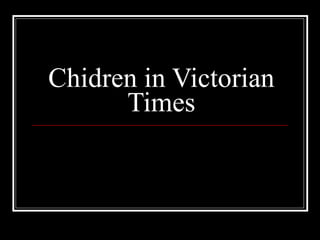
Children In Victorian Times
- 1. Chidren in Victorian Times
- 2. What was it like for children living in Victorian times? It all depended on their family…
- 3. Children from working class families... Ate poor food Worked long hours Lived in terrible conditions Many children died of disease.
- 4. Children from rich families… Ate healthy food Had clean and good clothes Didn’t need to work Went on holidays Had expensive toys
- 5. Working children At the age of 5 or 6 children started to work. Children worked very long hours with little breaks and no fresh air. They often worked in very dangerous conditions Children were paid very little because they were young.
- 6. Where did children work?
- 7. Children worked... In factories As chimney sweepers In coal mines In the streets In workhouses In farms
- 8. Children worked in factories They had to clean machines while the machines were kept running and there were many accidents.
- 9. In textile mills Many children lost fingers in the machinery and some kids were crushed by the huge machines and died.
- 10. In match factories… Children had to dip matches into dangerous chemicals. Those chemicals caused problems with their teeth and lungs.
- 11. Children worked as Chimney sweepers Small children starting at the age of 5 or 6 had to climb up inside the chimneys to clean them.The work was dangerous and painful.
- 12. Children worked in coal mines What jobs did they do in the mines? Were they dangerous?
- 13. They worked as drawers or trappers…
- 14. Children in the streets They sold flowers, bootlaces, matches or buttons. They polished shoes They ran errands They swept busy roads.
- 15. When did children stop working? Many efforts were made to finish with children labour and send them to school, but it wasn’t easy. Poor families needed the extra money so many children continued working.
- 16. According to the acts passed by the goverment… In 1832 the use of boys for sweeping chimneys was forbidden by law. In 1842 was forbidden the employment of woman and children in mines. In 1878 was prohibited the employment of children under 10 years old in factories.
- 17. What about now? What happen to many poor children?
- 18. Today many children have to work and most of them don’t go to school…
- 19. What can we do about this? Let’swork together!